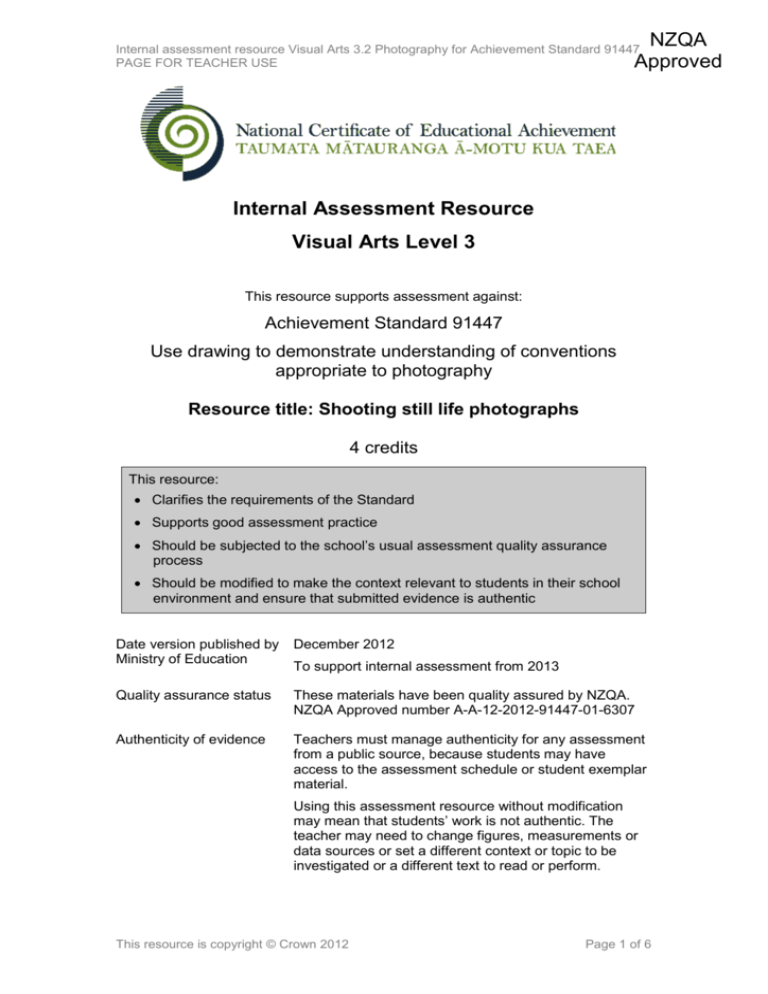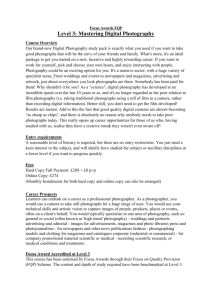3.2 photo - NCEA on TKI
advertisement

NZQA Approved Internal assessment resource Visual Arts 3.2 Photography for Achievement Standard 91447 PAGE FOR TEACHER USE Internal Assessment Resource Visual Arts Level 3 This resource supports assessment against: Achievement Standard 91447 Use drawing to demonstrate understanding of conventions appropriate to photography Resource title: Shooting still life photographs 4 credits This resource: Clarifies the requirements of the Standard Supports good assessment practice Should be subjected to the school’s usual assessment quality assurance process Should be modified to make the context relevant to students in their school environment and ensure that submitted evidence is authentic Date version published by Ministry of Education December 2012 Quality assurance status These materials have been quality assured by NZQA. NZQA Approved number A-A-12-2012-91447-01-6307 Authenticity of evidence Teachers must manage authenticity for any assessment from a public source, because students may have access to the assessment schedule or student exemplar material. To support internal assessment from 2013 Using this assessment resource without modification may mean that students’ work is not authentic. The teacher may need to change figures, measurements or data sources or set a different context or topic to be investigated or a different text to read or perform. This resource is copyright © Crown 2012 Page 1 of 6 Internal assessment resource Visual Arts 3.2 Photography for Achievement Standard 91447 PAGE FOR TEACHER USE Internal Assessment Resource Achievement Standard Visual Arts 91447: Use drawing to demonstrate understanding of conventions appropriate to photography Resource reference: Visual Arts 3.2 Photography Resource title: Shooting still life photographs Credits: 4 Teacher guidelines The following guidelines are supplied to enable teachers to carry out valid and consistent assessment using this internal assessment resource. Teachers need to be very familiar with the outcome being assessed by Achievement Standard Visual Arts 91447. The achievement criteria and the explanatory notes contain information, definitions, and requirements that are crucial when interpreting the Standard and assessing students against it. Context/setting This assessment activity requires students to produce a set of photographic drawings based on the genre of still life. The body of work created during this assessment activity could form the starting point for a submission in Achievement Standard 91452 Photography. Conditions This individual assessment activity will take place over six weeks of in-class and outof-class time. Resource requirements Access to appropriate camera and printing equipment Where digital processes are used students will need access to computers and software suitable for the manipulation of images, for example, Adobe Photoshop Access to a range of visual and written resources detailing issues around the genre of still life. Additional information It is suggested that prior to beginning this assessment activity, approximately two weeks are spent investigating ideas and issues relating to the genre of still life. This learning provides the opportunity for students to demonstrate the in-depth understanding required for Excellence. It is not a requirement for assessment of the Standard. This resource is copyright © Crown 2012 Page 2 of 6 Internal assessment resource Visual Arts 3.2 Photography for Achievement Standard 91447 PAGE FOR STUDENT USE Internal Assessment Resource Achievement Standard Visual Arts 91447: Use drawing to demonstrate understanding of conventions appropriate to photography Resource reference: Visual Arts 3.2 Photography Resource title: Shooting still life photographs Credits: 4 Achievement Use drawing to demonstrate understanding of conventions appropriate to photography. Achievement with Merit Use drawing to demonstrate understanding of specific conventions appropriate to photography. Achievement with Excellence Use drawing to demonstrate in-depth understanding of specific conventions appropriate to photography. Student instructions Introduction This assessment activity requires you to produce a set of photographic drawings based on the genre of still life. This is an individual assessment activity, and you will present your photographic drawings on an A1 panel accompanied by a journal. Teacher note: Possible alternative methods of presentation include journal or workbook only, A3 clear file, or wall display. The assessment will take approximately six weeks of in-class and out-of-class time, and your teacher will confirm timeframes for individual activities. You will be assessed on how well you show a critical selection and fluent application of processes, procedures, materials, techniques, and art-making conventions appropriate to photography. Preparatory activity (not assessed) Research and generate ideas Still life is a broad theme that offers you a wide range of pictorial opportunities depending on the approach you take. Opportunities include: close-up views of a single object arrangement of a group of objects multiples of similar objects exploration of domestic or gender issues exploration of one type of material a scene in your home that appeals to you formal arrangement of subject matter use of symbolic objects. This resource is copyright © Crown 2012 Page 3 of 6 Internal assessment resource Visual Arts 3.2 Photography for Achievement Standard 91447 PAGE FOR STUDENT USE Record ideas of still life subject matter that interest you and clarify any ideas that you want to investigate. Record your brainstorming in an appropriate format, for example, mind maps, thumbnails, annotated drawings, or notes. Identify four to six works from artists who are relevant to this task. Relevance could include subject matter, stylistic concerns, conceptual aspects, and techniques or processes. Consider artists’ works from all fields of art practice, not just photography. Include a range of approaches with different types of outcomes. See Resource A for a list of possible artists. In your research, focus on making decisions about the type of still life and specific objects that you want to use in your photographic drawings. Task Generate images from subject matter Identify the approaches to still life that particularly interest you and gather props and objects to photograph. Complete a photo-shoot of your still life objects using a range of pictorial and photographic conventions. Conventions include visual information from your earlier research on particular artists, as well as pictorial and technical conventions (for example, placement of objects, scale of objects, viewpoint, depth of field, selective focus, lighting, composition, tonal range, colour, format, and editing). Make a proof sheet (digital or analogue) and then make six proof prints of the most successful images. Use bullet point annotations to critique these eight images. Evaluate the strengths and weaknesses of your images in relation to identified still life and photographic conventions. Explain how you could further explore conventions appropriate to still life. This reflection is critical to show an in-depth understanding. You may need to look at more artists at this stage to add to your understanding of subject matter, and compositional and technical considerations. Shoot further images based on critical reflection Complete a second photo-shoot of the same still life objects, make a proof sheet, and enlarge six images. Use bullet point annotations to comment about your use of photographic conventions, techniques, and materials, and about the success of the images in relation to photographic techniques and the genre of still life. At this stage you may use digital manipulation techniques to enhance your images. This may include vignette, contrast correction, adjusting saturation, or photomontage. Make notes in your journal and include examples of any relevant technical manipulations. Refer to artist models for any technical explorations you undertake. Demonstrate that you are using photography skills purposefully and fluently. Select and present your photographic drawings Print eight to 12 images to fit an A1 panel. Works may be different sizes; some will be small sets of works and some will communicate more resolved ideas as individual images. The layout should be clearly considered and planned. Hand in your A1 panel accompanied by the journal that shows your critical reflection. This resource is copyright © Crown 2012 Page 4 of 6 Internal assessment resource Visual Arts 3.2 Photography for Achievement Standard 91447 PAGE FOR STUDENT USE Resource A Painters: 17th-century still life paintings Chardin Cotan Cezanne Morandi Richard Diebenkorn Wayne Thiebaud Laurie Simmons Lisa Milroy Peter Madden Photographers: Man Ray Josef Sudek Andre Kertesz Edward Weston Paul Outerbridge Tina Modotti Margaret Watkins Florence Henri Eileen Cowin Peter Peryer Anne Noble Fiona Pardington Lilo Raymond Bauhaus group Audrey Flack Starn brothers Laura Letinsky Joachim Froese This resource is copyright © Crown 2012 Page 5 of 6 Internal assessment resource Visual Arts 3.2 Photography for Achievement Standard 91447 PAGE FOR TEACHER USE Assessment schedule: Visual Arts 91447 Photography – Shooting still life photographs Evidence/Judgements for Achievement Evidence/Judgements for Achievement with Merit Evidence/Judgements for Achievement with Excellence The student uses drawing to demonstrate understanding of conventions appropriate to photography. The student’s final selection of images makes use of photography processes, procedures, materials, techniques, and pictorial conventions when making their photographs. The student demonstrates correct use of technical skills, with most works showing correct exposure, appropriate tonal range, and/or colour. The images are selected from proof sheets. An understanding of pictorial issues in art-making is evident. This includes a consideration of composition, framing devices, viewpoints, and formats. The use of established practice from research of artists is evident in the student’s work. The student uses drawing to demonstrate understanding of specific conventions appropriate to photography. The student’s final selection of images makes purposeful use of processes, procedures, materials, techniques, and pictorial conventions when making their photographs. The student demonstrates correct use of refined technical skills, showing correct exposure, appropriate tonal range, and/or colour. The images are purposefully selected and edited from proof sheets. Proof sheets offer options from which the selection is made. Images are formatted and sized according to the desired reading of the work. A thorough understanding of pictorial issues in artmaking is evident. This includes considered compositions, framing devices, viewpoints and formats that are purposeful and reference established practice from the student’s research. The work shows that established practice from research of artists has been used to make specific decisions in the student’s work. The student uses drawing to demonstrate in-depth understanding of specific conventions appropriate to photography. The student’s final selection of images shows critical and fluent application of processes, procedures, materials, techniques, and pictorial conventions when making their photographs. The student demonstrates a high level of technical skills, with works showing correct and consistent exposure. The various functions of tonal range and/or colour are explored in-depth. The images are critically selected and edited from proof sheets. Proof sheets offer a range of options from which the selection is made. Images are formatted and sized according to the desired reading of the work. A thorough understanding of pictorial issues in artmaking is evident. This includes carefully considered compositions, framing devices, and a range of viewpoints and formats that are purposeful and reference established practice from the student’s research. The work shows that established practice from research of artists has been used to underpin decision-making in the student’s work. Final grades will be decided using professional judgement based on a holistic examination of the evidence provided against the criteria in the Achievement Standard. This resource is copyright © Crown 2012 Page 6 of 6







